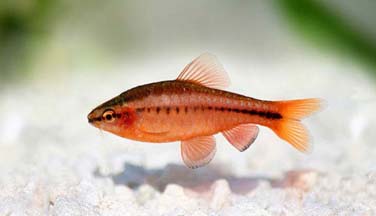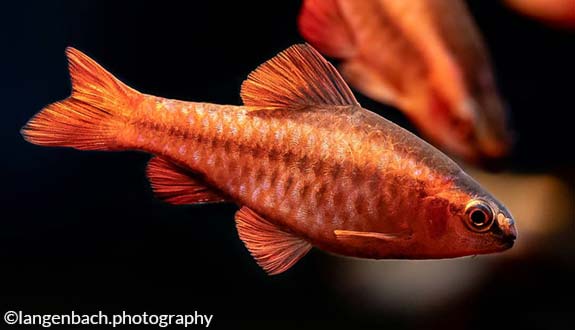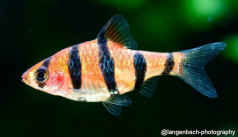

Alternative species (click on the thumbnail to see the card)
Names
Scientific name
Puntius titterya
Barbus titteya
Capoeta titteya
Common name
Cherry Barb
Origin

Origin: Sri Lanka
Biotope: Asian
Dimorphism

The male is red and the female is brownish with marked lateral band
Group

Cyprinidae
Volume

120 L / 26 imp gal / 32 US gal
Parameters

T°: 23 à 26°C or 73 to 79°F
pH: 6 to 7
Hardness: 3 to 10°dGH
Difficulty

Easy
Size

4 to 5cm (1.6 to 2")
Longevity

3 years
Living zone

Middle and Depth
Individuals

10
Food
How to feed the Cherry Barb?
Food
How to feed the Cherry Barb?
Omnivorous: all forms of small food are accepted with plant supplements. It is best to give them their daily ration in several times. Occasionally, fasting is recommended. The colors of cherry Barb will be more beautiful with a varied diet and frequent intake of live or frozen food.
Behavior
What kind of behavior does the Cherry Barb have?
Behavior
What kind of behavior does the Cherry Barb have?
Reserved and peaceful by nature (a rarity among the Barbus!). They are gregarious and must be kept in groups, even if they do not form a real shoal. For that, make up your group with 1 male for 2 females to decrease the harassment of the males towards the females. Males sometimes fight each other to defend their position in the hierarchy. However, most of the time, they will engage in perfectly harmless intimidation displays. It should also be noted that the presence of several males promotes the beautiful coloration of these fish.
Cohabitation
Who can live with the Cherry Barb?
Cohabitation
Who can live with the Cherry Barb?
A specific aquarium is preferable. Indeed, these shy fish do not have a natural behavior in community aquariums. They can nevertheless live in a aquarium with quiet species such as Gouramis or Colisas.
Breeding
How to breed the Cherry Barb?
Breeding
How to breed the Cherry Barb?
Like most Barbus, the breeding of the Cherry Barb is relatively easy and sometimes occurs without human intervention. Nevertheless, for a better survival of the fry, prefer to dedicate a tank for the breeding. You must install a dark substrate, a protective grid at the bottom and fill it with fine-leaved plants such as Taxiphyllum or Java Moss. Finally, sift the light with many floating plants. The temperature will be around 25/27°C or 77/81°F and pH 6.5/7. Condition the couple before feeding them abundantly with live prey and then introduce them into the breeding tank. The laying can go up to 300 eggs and the incubation lasts 24 hours. When the fry begin to swim, lower the water level, then gradually raise it according to their growth./p>
Fry food: nauplies of artemia and cyclops.
Its aquarium
Which aquarium for the Cherry Barb?
Its aquarium
Which aquarium for the Cherry Barb?
A specific aquarium is preferable. Although the decoration of the Cherry Barb is not particularly a sensitive point, it is best to keep it in a well planted aquarium, with hiding places and a large swimming area. Also prefer a dark substrate and add a few floating plants. For a more natural sensation, sprinkle the soil with a few dried leaves.
Good To know
Find all additional information!
Good To know
Find all additional information!

Sturdy enough, this species is suitable for beginners. It is therefore widely used in aquariums.
Puntius titterya has barbels at the corner of the lips.
Note that there is an Albino variety and a Super red.
Yours photos!
Comments
Sort by:
Please login to post comments



